Sekihan or Red Bean Rice is a traditional rice dish served on happy occasions in Japan. Glutinous rice is cooked with azuki beans till chewy and tender and topped with a sprinkle of salt and black sesame seeds.
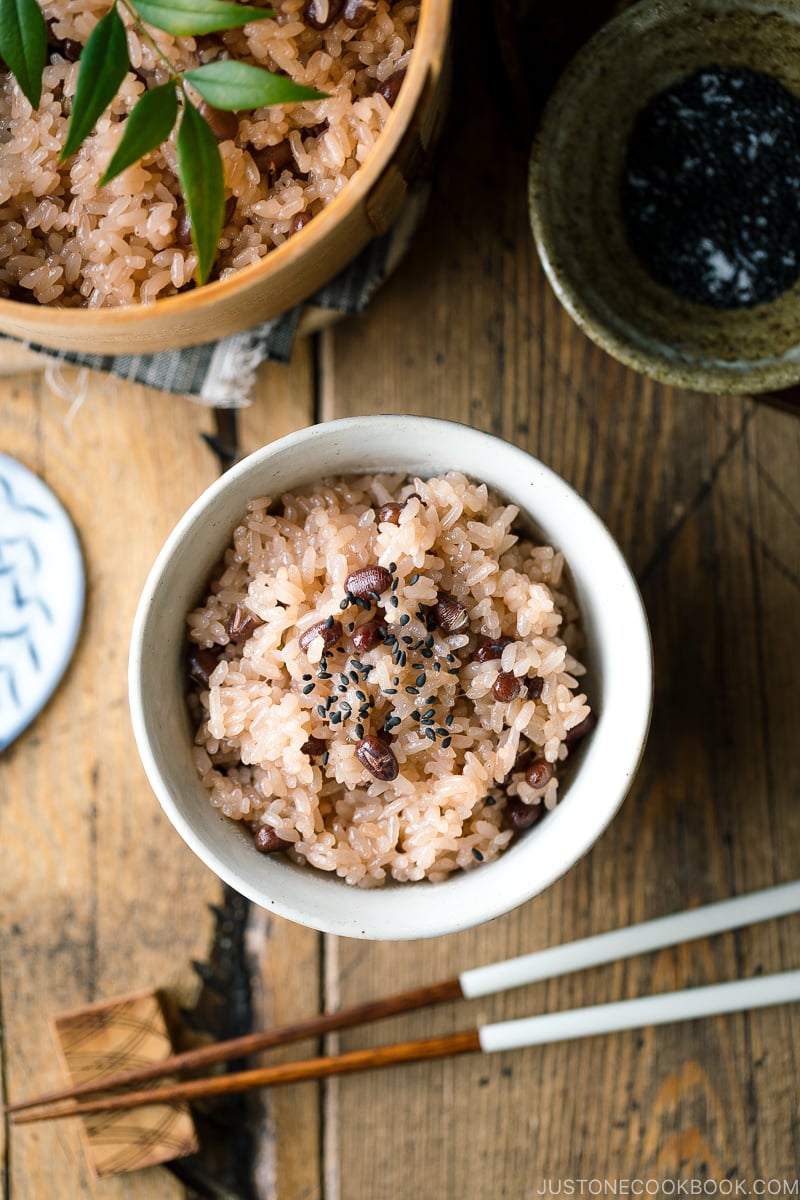
What are some of the celebratory dishes in your culture? In Japan, we have quite a number of foods that we eat on special occasions. One of them is Sekihan (赤飯) or Japanese Red Bean Rice. To usher in birthdays, graduations, weddings, or Japanese New Year, let’s learn how to make this beautiful bean and rice dish today.
Table of Contents
What is Sekihan?
Sekihan (赤飯) translates to “red rice” in Japanese as the glutinous rice is tinted with an attractive shade of red hue from cooking with azuki (adzuki) beans. The red color of the rice symbolizes happiness and prosperity. It’s a traditional dish served on happy and celebratory occasions such as New Year, the birth of a baby, birthdays, festivals, and weddings.
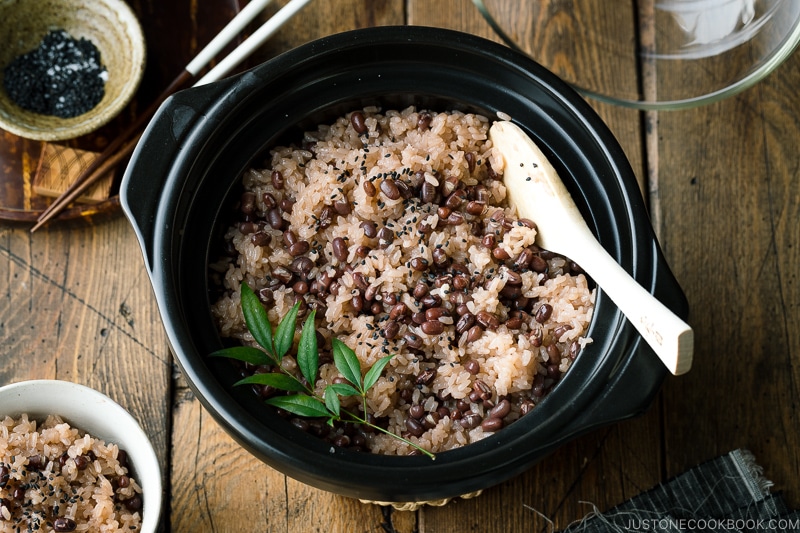
Traditionally, sekihan is made of 100% glutinous rice (also called sweet rice or mochigome). It’s a sticky rice that is very filling and heavy on the stomach, so we don’t eat it regularly.
There are also regional varieties of the sekihan. Some versions use a pinch of sugar instead of salt to give a sweet flavor, and some use other kinds of beans such as amanatto (sweetened bean confectionery, 甘納豆) or sasage (black cowpea beans, ササゲ) instead of azuki beans.
The unique thing about sekihan is that we often serve it at room temperature. Regular steamed rice is never served at room temperature unless it’s in a form of rice balls (onigiri) or in a lunch box.
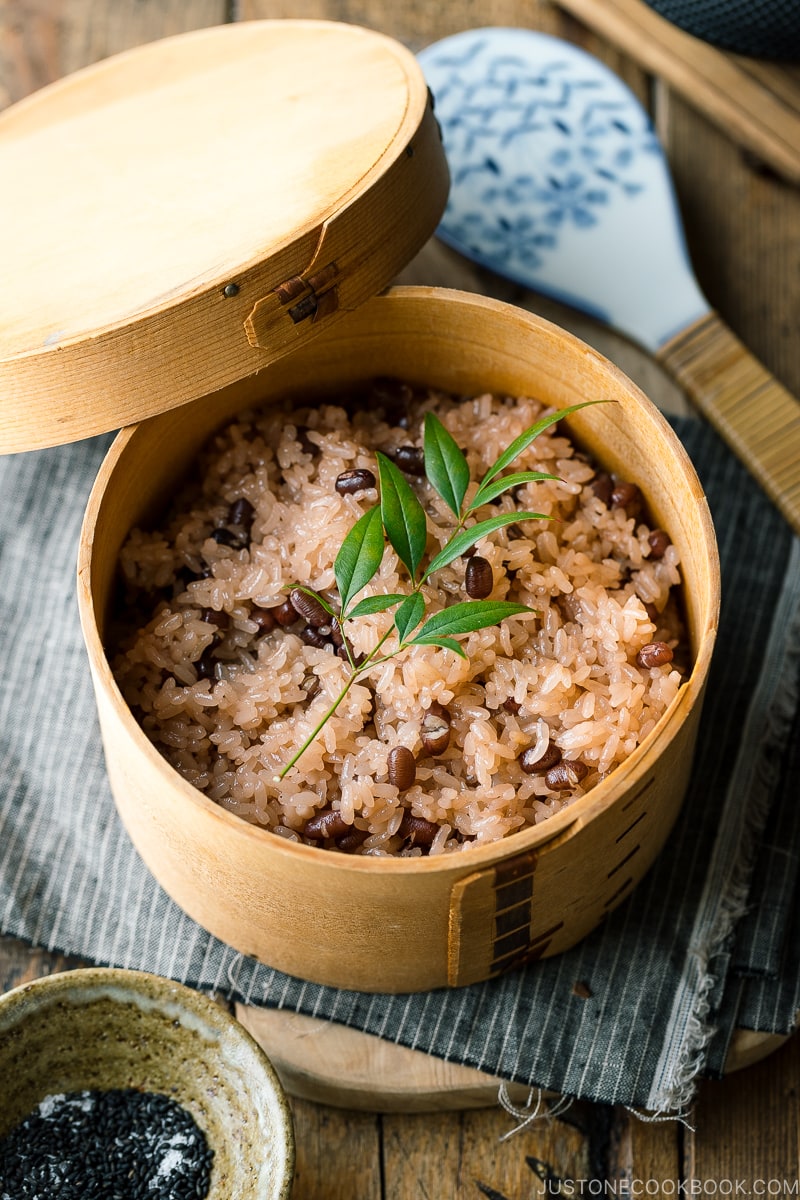
Azuki Red Beans in Japanese Cuisine
In Japanese cooking, azuki beans (or adzuki beans) are almost exclusively used in making Japanese sweets or pastries. The beans are boiled, mashed, sweetened, and then used as fillings in Daifuku Mochi, Manju, Dorayaki, Red Bean Ice Cream, Anpan, and so on.
In this instance, however, azuki beans make a rare appearance in a non-sweet dish that is rather unique to Japanese cuisine. It replicates the ancient red rice in Japan and brings many great meanings to the culture.
Look for azuki red beans in Japanese or Asian grocery stores or on Amazon.
Ingredients You’ll Need
- Japanese glutinous rice (sweet rice, mochigome, もち米)
- azuki beans
- salt
- black sesame seeds – if your sesame seeds are not toasted, you can toast them in a non-greased frying pan until they begin to pop
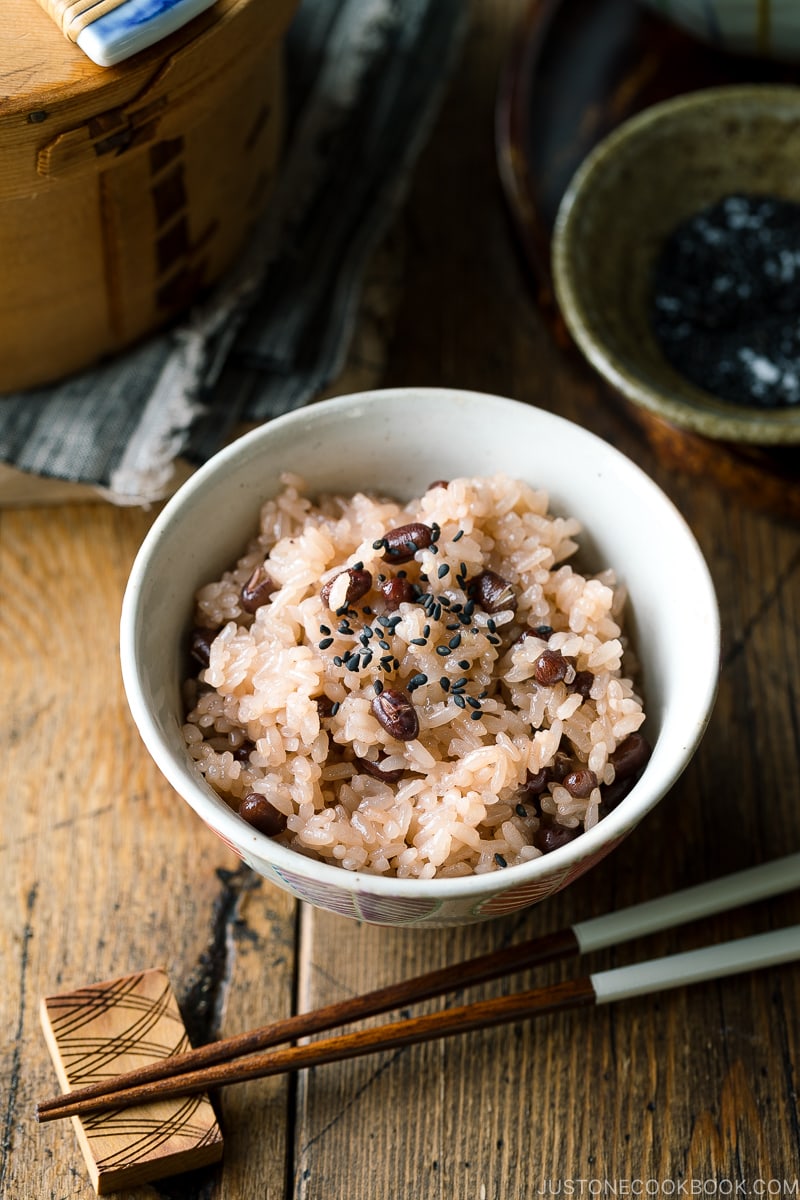
How To Make Sekihan (Red Bean Rice)
- Boil the azuki beans twice. Discard the first cooking liquid to remove astringency, but reserve the second cooking liquid.
- Cool the beans and reserved cooking liquid to room temperature.
- Combine the rinsed rice, salt, and bean-cooking liquid. Top it with the cooked azuki beans.
- Cook until tender. It takes less than 60 minutes in a rice cooker (including steaming time), or 12–14 minutes on the stovetop plus 20 minutes of steaming off the heat. My recipe below shows both stovetop and rice cooker methods.
- Serve and sprinkle with gomashio (ごま塩), a mixture of toasted black sesame seeds and salt. Sekihan is also delicious on its own, especially with the rice’s toothsome texture and wonderful fragrance from the red beans.
Tips on Cooking Sekihan
Prepping the Ingredients
- Use Japanese short-grain glutinous rice – It is not the same as Thai or Chinese long-grain glutinous rice. The color of glutinous rice is white as opposed to the semi-transparent color of the regular Japanese short-grain rice. Look for the rice packages indicating mochigome (もち米) in Japanese/Korean grocery stores. You can read more about it on our pantry page.
- Gently rinse the glutinous rice – Unlike regular white rice, glutinous rice grains are fragile and break easily, so don’t use a fine-mesh sieve/strainer to wash the rice.
- No need to soak glutinous rice – Glutinous rice absorbs water well, so you do not need to soak it unless you are going to steam the glutinous rice (not my recipe).
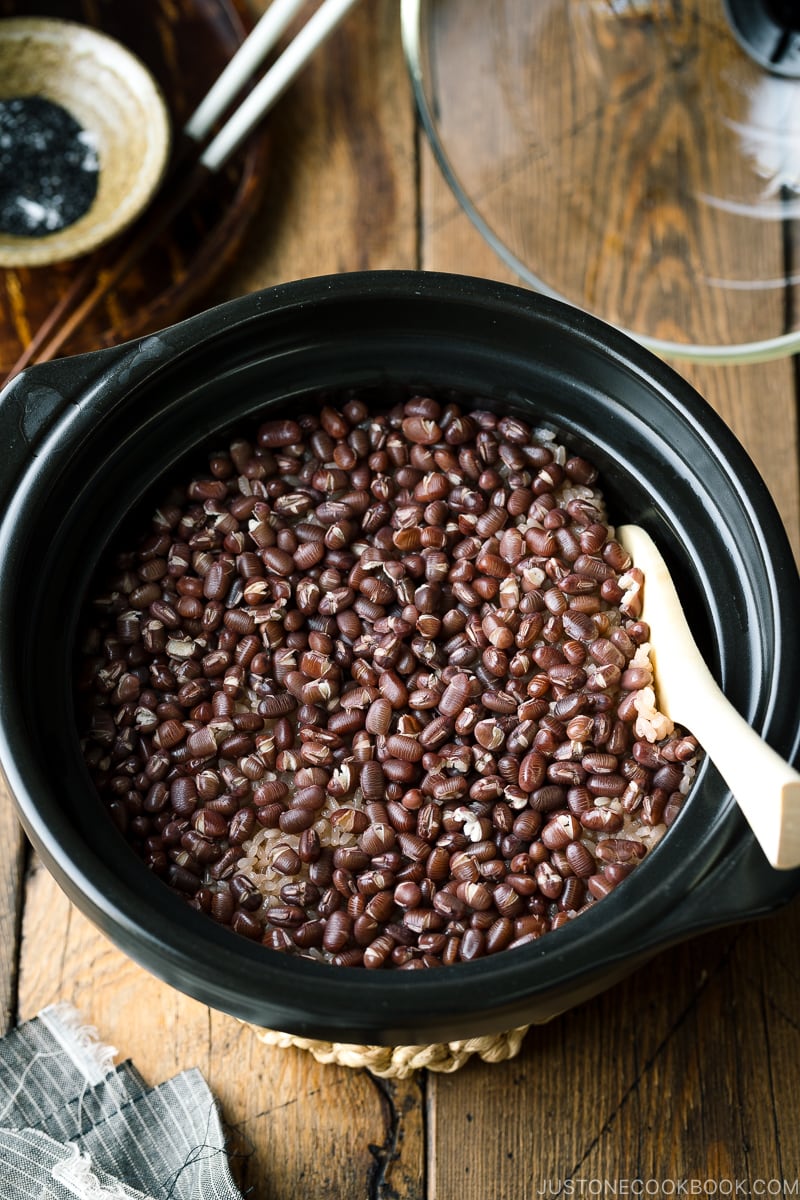
Cooking the Azuki Beans
- Use a pot with a tight-fitting lid – The goal is to preserve enough azuki-cooking liquid that we will use to cook the rice. Use a tight-fitting lid to limit the evaporation. (Side note: Staub has a tighter fitting lid than Le Creuset!)
- Discard the first azuki-cooking liquid – Azuki beans release some astringency, so the first cooking water should be discarded.
- Cool beans and azuki-cooking liquid to room temp – Make sure you plan well so you have enough time for the beans and cooking liquid to cool completely. NEVER cook the glutinous rice with hot/warm cooking liquid. Keep the beans in the azuki-cooking liquid as hot liquid will continue to cook the beans. Separate the beans and liquid after cooling down. This will also prevent beans from getting wrinkled.
Cooking the Sekihan
- Use a water-to-rice ratio of 1 to 1 by volume (NOT by weight) – Use 1 part glutinous rice, 1 part azuki-cooking liquid. To cook 3 rice cooker cups of glutinous rice, you will need 3 rice cooker cups liquid, which is 540 ml (180 ml x 3). I use a digital kitchen scale for to measure 540 ml precisely.
- Use gentle heat to cook – Use medium to medium-high heat to boil, but once boiling, the heat should be a gentle simmer to avoid burning the rice.
- Let steam for 20 minutes – This is not an optional, it’s a mandatory cooking step. The rice cooker’s “cooking time” includes this 20-minute steaming time in the program.
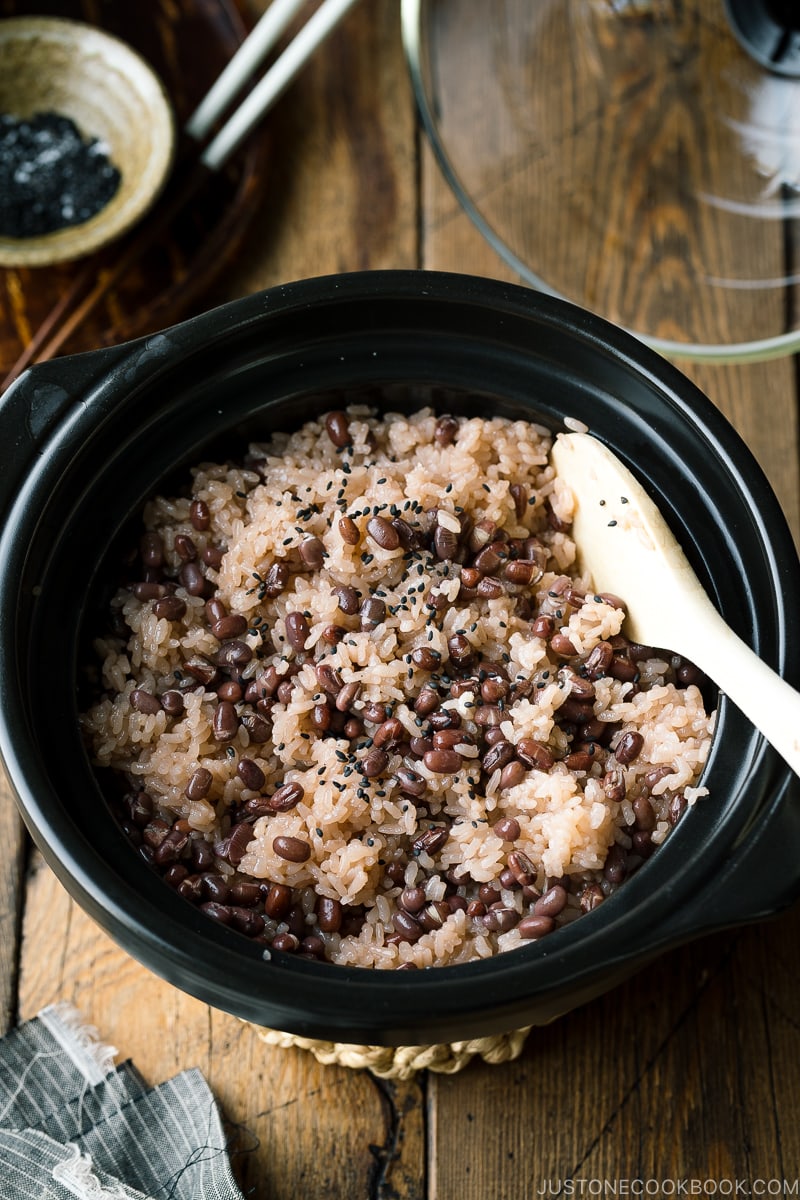
FAQs
1. Do we need to use the Japanese variety of glutinous rice (sweet rice)?
Yes! It’s important to use the Japanese short-grain glutinous rice (sweet rice) for this recipe. It is not the same as Thai or Chinese long-grain glutinous rice. The color of Japanese glutinous rice is white as opposed to the semi-transparent color of the regular Japanese short-grain rice.
Look for it in Japanese/Korean grocery stores. On the rice packages, the label should indicate mochigome or もち米. You can read more about it on our pantry page.
Be gentle when you rinse the rice, as glutinous rice is easy to break.
2. Do we soak glutinous rice (sweet rice)?
When we cook standard Japanese short-grain rice, it is very important to soak the rice before cooking so the rice absorbs some water and becomes tender when cooked.
However, when cooking glutinous rice (sweet rice), we do not need to soak it in water if it’s cooked in a rice cooker, pressure cooker, or a pot over the stovetop. In another word, you have to soak the glutinous rice if you’re going to steam it.
Because glutinous rice is easy to absorb water, soaking is not necessary. If you soak the glutinous rice, and then cook it (in the water) in the rice cooker/pressure cooker/pot, it ends up soggy and mushy.
When you steam glutinous rice, it’s best to soak at least 2 hours, or ideally overnight.
3. Do we soak azuki beans?
Soaking the dried azuki beans overnight or as long as 16 hours will help to reduce the cooking time. As azuki beans have a hard shell, soaking for a few hours or even overnight is not long enough to make a difference. These days many azuki bean packages recommend cooking beans straight from the package without soaking.
However, there are other benefits of soaking beans. For example, the water helps absorb some of the complex sugars in the beans that cause gas.
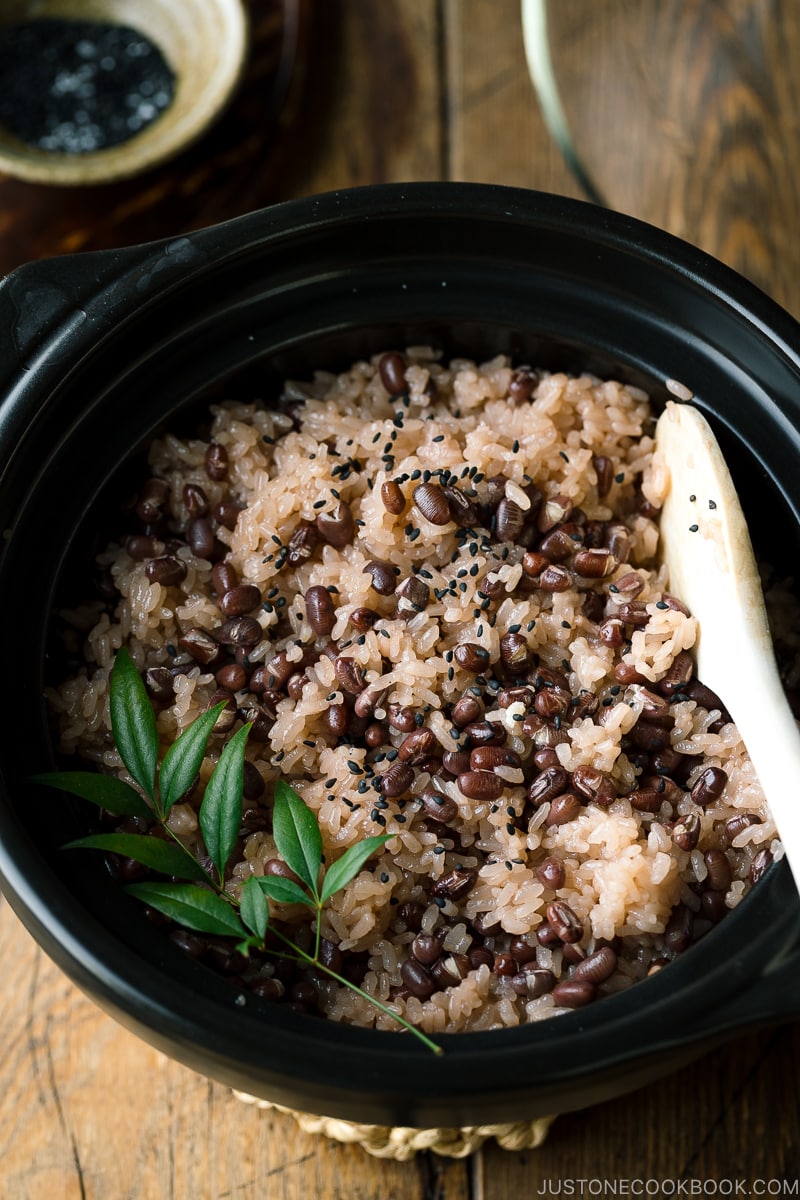
4. Why don’t you use the steaming method?
Traditionally, glutinous rice dishes like sekihan and okowa (Japanese sticky rice) are made in a steamer and I believe the texture of the rice made in the steamer is the absolute best. Not mushy or soggy, just perfectly cooked rice. However, most Japanese households prepare sekihan using a rice cooker as it is convenient and fast, and offers a consistent result.
The steaming method is a bit fussy with a few extra steps and it’s not as easy as other cooking methods. When I prepare sekihan for my family, I’ve only used my rice cooker, pressure cooker, and a pot over the stovetop, and I’ve never used a steamer. Therefore, from my own experience, I’ve decided to share my sekihan recipe using tools most people have.
5. Why do some recipes also add regular white rice?
You may have encountered recipes that use a mixture of glutinous rice and standard Japanese short-grain rice.
Although sekihan is traditionally made with 100% glutinous rice, some people add a small portion of regular rice to reduce stickier/mushy texture when cooking in a rice cooker or on the stovetop (less problem with a steamer). Also, when sekihan is cooked with glutinous rice, the rice gets harder as it cools. Adding a small amount of regular white rice is supposed to ease that issue.
I like sekihan with 100% glutinous rice but if you want to try combining glutinous rice and regular rice, I recommend the ratio of 2½ rice cooker cup of glutinous rice and ½ cup regular short-grain rice.
Let’s Celebrate with Sekihan
We have a saying in Japan—”Let’s have sekihan!”—that means “Let’s celebrate!” I hope you get a chance to make this tasty, auspicious dish for your next celebration.
Other Delicious Rice Recipes
- Kuri Gohan (Chestnut Rice)
- Matsutake Gohan (Wild Pine Mushroom Rice)
- Takenoko Gohan (Bamboo Rice)
- Mame Gohan (Green Pea Rice)
- Sansai Gohan (Mountain Vegetable Rice)
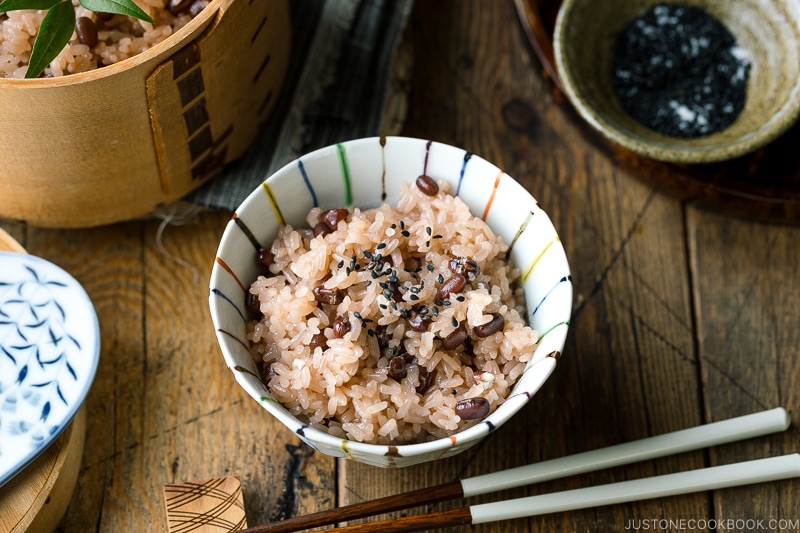
Sign up for the free Just One Cookbook newsletter delivered to your inbox! And stay in touch with me on Facebook, Pinterest, YouTube, and Instagram for all the latest updates.
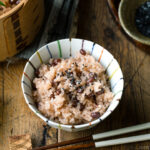
Sekihan (Red Bean Rice)
Video
Ingredients
- ⅓ cup azuki beans (½ rice cooker cup, ½合)
- 1½ cups water (for cooking beans #1)
- 3½ cups water (for cooking beans #2)
- 2¼ cups sweet rice/glutinous rice (mochigome) (3 rice cooker cups, 3合, 540 ml)
- ½ tsp Diamond Crystal kosher salt (for cooking the rice)
For Serving
- 1 Tbsp toasted black sesame seeds (or use gomashio, which is the combination of black sesame seeds and salt)
- ½ tsp Diamond Crystal kosher salt
Instructions
- Before You Start…Please note that this recipe requires 1 hour of cooling time.Gather all the ingredients.
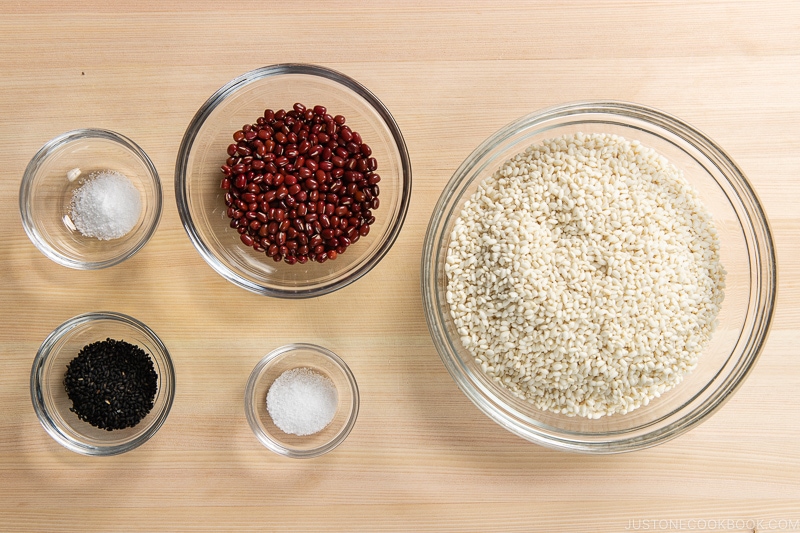
To Cook Azuki Beans
- Rinse ⅓ cup azuki beans in the strainer under cold running water and drain well.
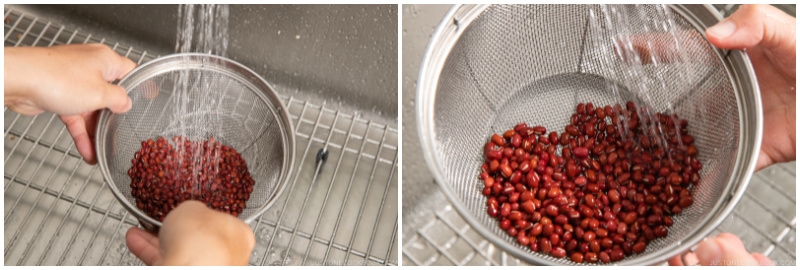
- Put the azuki beans in a large pot (with a tight-fitting lid) with 1½ cups water.
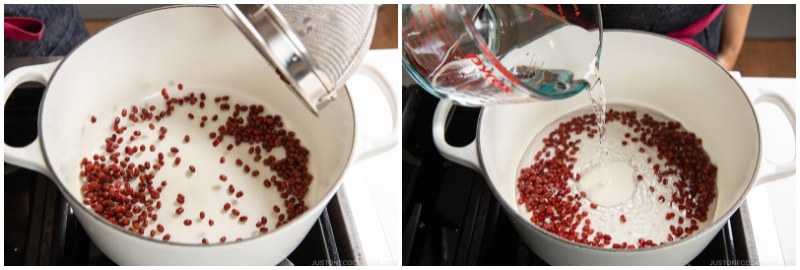
- Bring it to a boil over medium heat. Once boiling, turn off the heat and drain the beans over the strainer.
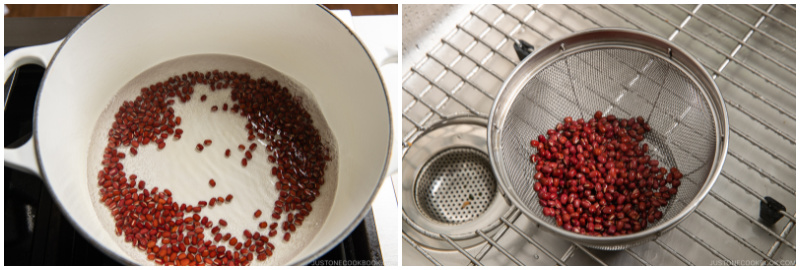
- Put the beans back in the pot and add 3½ cups water. Bring it to a boil.
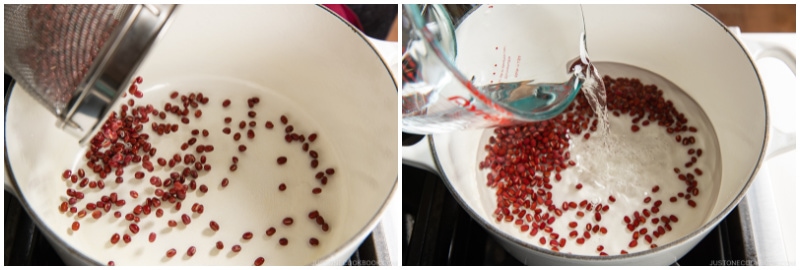
- Once it‘s boiling, turn down the heat to low/simmer. Cover and cook for 25–30 minutes. Note: If your azuki beans are old, no matter how long you cook them, they won‘t become tender. So, make sure the beans are fresh. The beans will continue to cook with the glutinous rice, so they should be tender but don‘t have to be 100% cooked at this stage. I personally prefer the beans to have some texture instead of being mushy. Please adjust the cooking time for the beans accordingly.
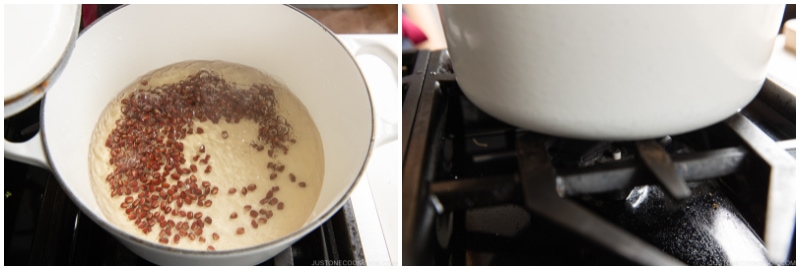
- Check the doneness of the beans by mashing one bean between your two fingers. As I prefer the beans to have some texture, when I test the bean, the texture should still be somewhat firm, not completely soft. Remove from the heat and let cool to room temperature, roughly 1 hour. The beans will continue to cook with the remaining heat.
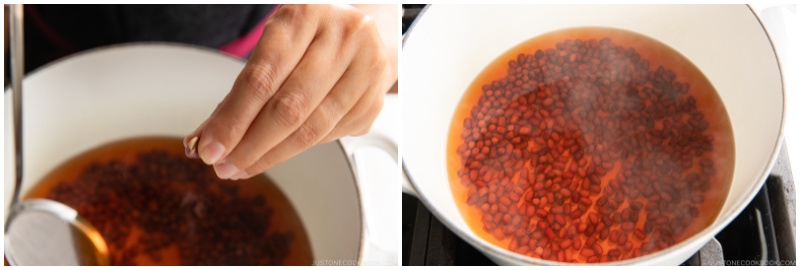
To Measure the Rice Cooking Liquid
- Once the azuki beans and azuki-cooking liquid come to room temperature, separate them. You will use the azuki-cooking liquid to cook the rice. You must have 540 ml cooking liquid. If you don‘t have enough, add water so you‘ll have exact 540 ml.
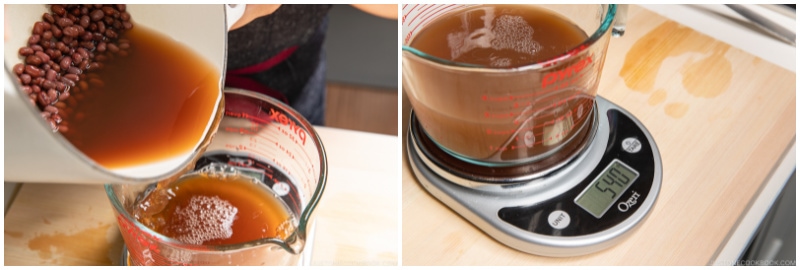
To Rinse the Rice
- In a large bowl, place 2¼ cups sweet rice/glutinous rice (mochigome). Add water to submerge it and quickly discard the water.
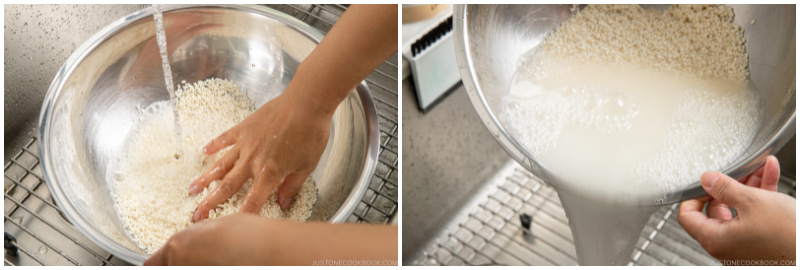
- Add water and gently rinse the rice 3 to 4 more times until the water is clear. Unlike regular white rice, sweet rice breaks easily, so be gentle when you rinse.
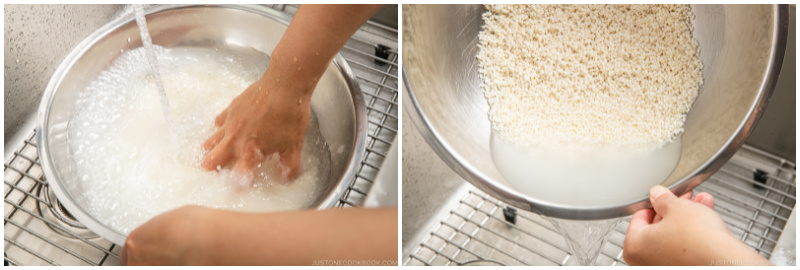
- For one last time, add water to the bowl and drain the rice into the strainer. Drain and shake off the water well.
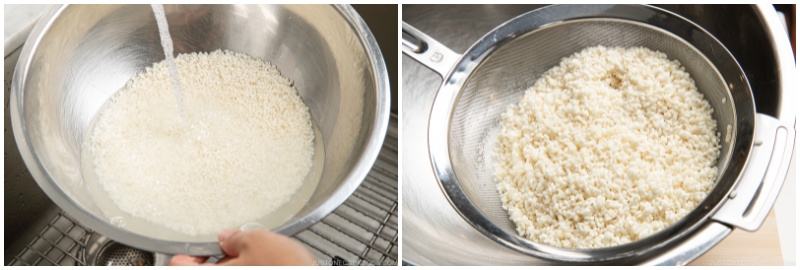
To Cook the Sekihan in a Rice Cooker
- Add the drained rice and 540 ml azuki-cooking liquid to the rice cooker bowl. The liquid should be at the 3-cup line for Sweet Rice. If your rice cooker does not have Sweet Rice mode, your liquid should be less than the 3-cup line for White Rice.

- Add ½ tsp Diamond Crystal kosher salt and mix well together.
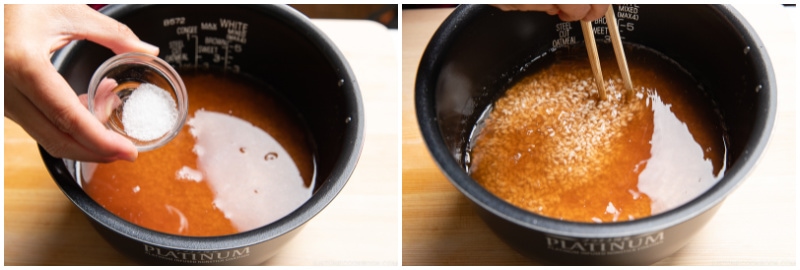
- Add the beans on top and evenly distribute but try not to mix with rice. Rice cooks evenly when it‘s not mixed with other ingredients.
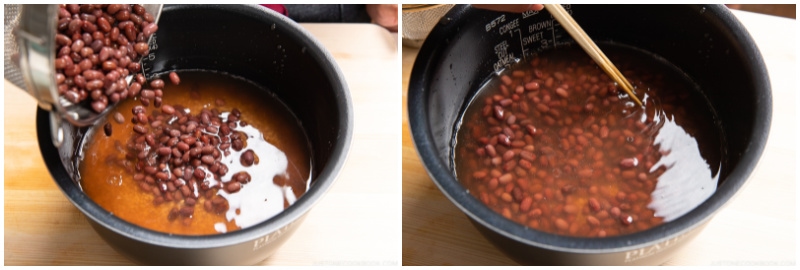
- Press start to cook. Once it‘s done cooking, keep the lid closed for an additional 10–15 minutes.
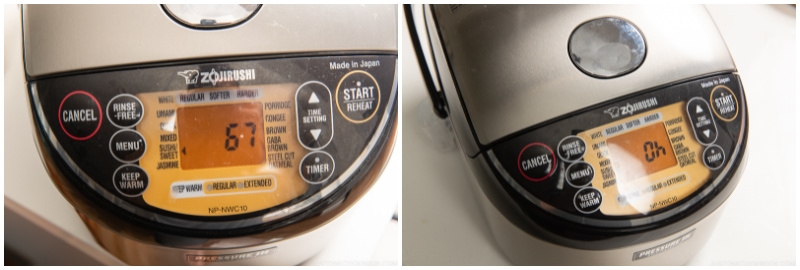
To Cook the Sekihan on the Stovetop
- Add the drained rice and 540 ml azuki-cooking liquid to the pot or donabe.
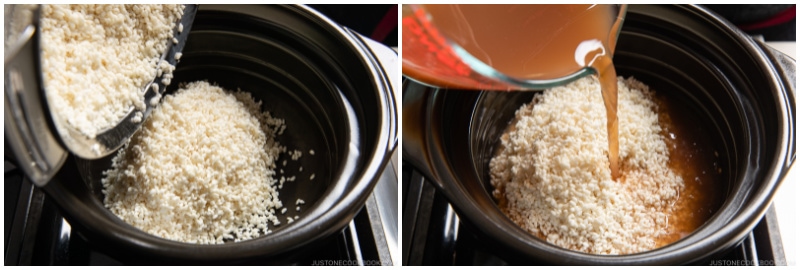
- Add ½ tsp Diamond Crystal kosher salt and mix well together.
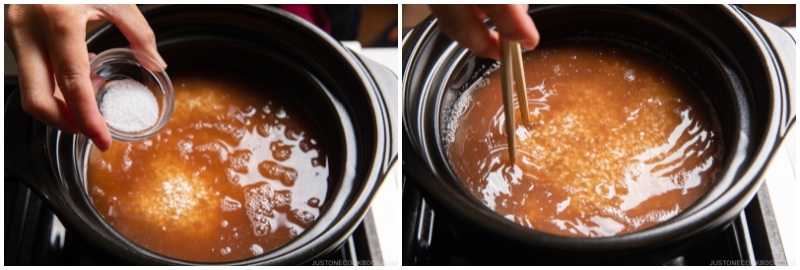
- Add the beans on top and evenly distribute but try not to mix with rice. Rice cooks evenly when it‘s not mixed with other ingredients.
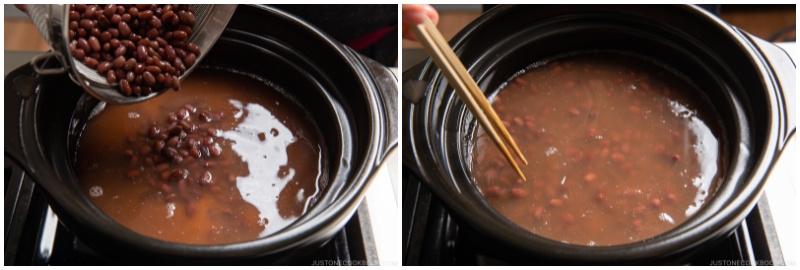
- Cover the lid and start cooking on medium-high heat until boiling, roughly 8–10 minutes.
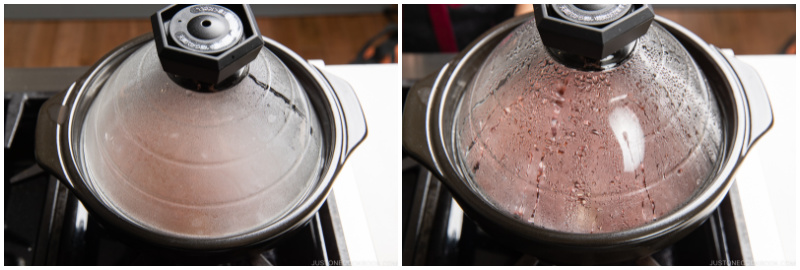
- Once boiling, reduce the heat to low/simmer and cook for 10–12 minutes. Remove from the heat (so the bottom doesn‘t get burnt) and let it steam for an additional 20 minutes.
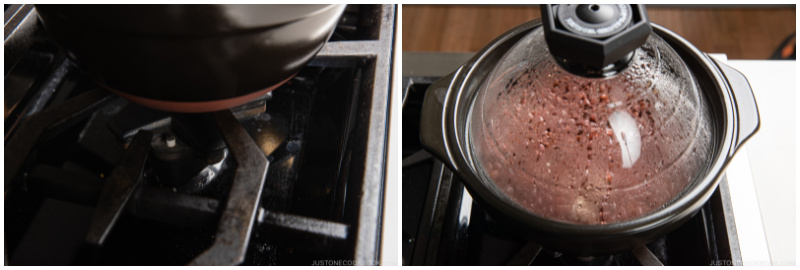
To Serve
- Mix 1 Tbsp toasted black sesame seeds and ½ tsp Diamond Crystal kosher salt. This is called gomashio (ごま塩).
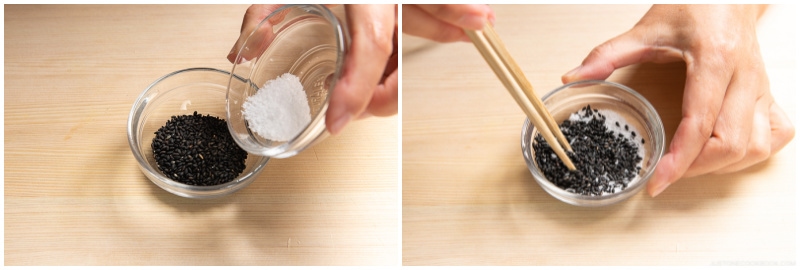
- Fluff the rice gently. Insert the rice scooper perpendicularly, lifting up the rice from the bottom (see the next step).
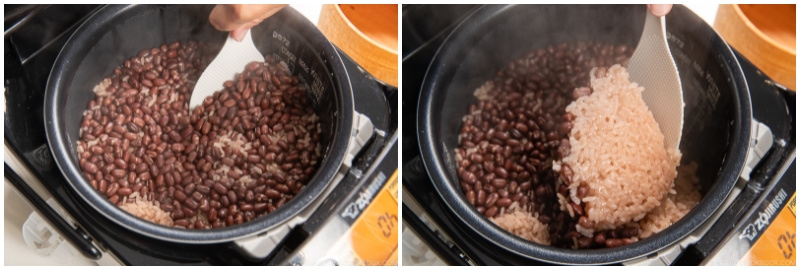
- Then, break it up with the rice scooper perpendicularly, as if you‘re cutting it. Repeat the same process until all the rice at the bottom of the pot is fluffed. Serve to individual rice bowls and sprinkle gomashio on top. Enjoy!
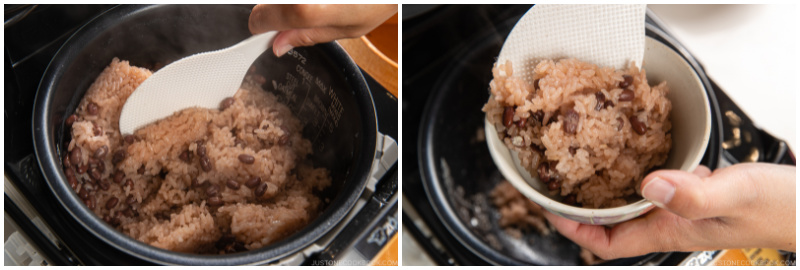
To Store
- You can keep the leftovers in an airtight container and store in the refrigerator for up to 2 days or in the freezer for a month.
Nutrition
Editor’s Note: The post was originally published on January 9, 2012. New images and video are added to the post and the content has been updated in May 2021.
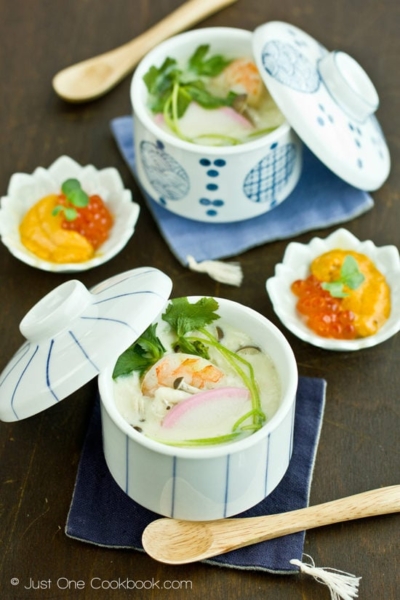
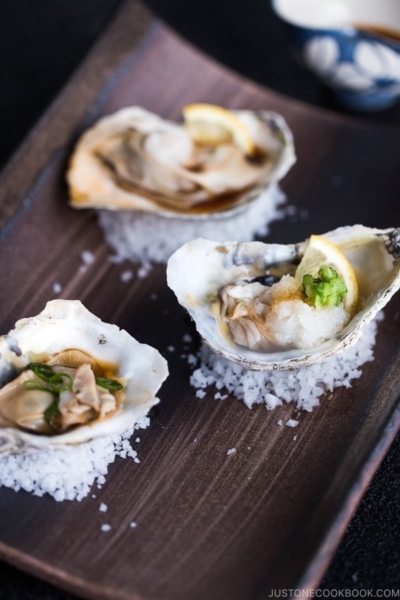
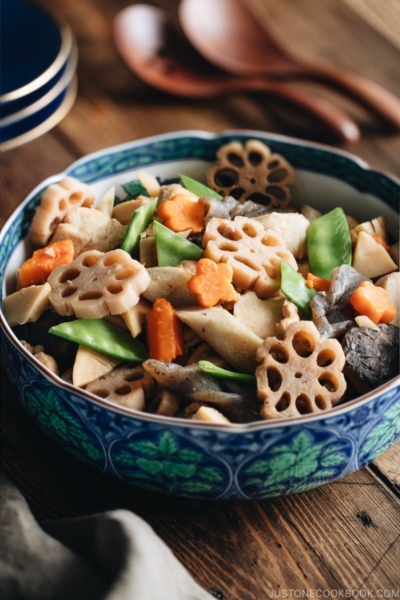
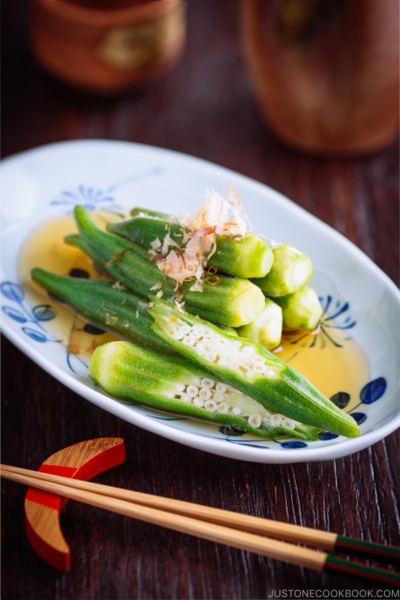




I was very surprised by this recipe, I didn’t know what to expect as I had never eaten this before nor had I even heard of it. The ingredients and preparation were simple as were the steps to make it and the flavor was so subtle yet kind of complex? Definitely making this again, thank you Namiko!
Hi Beckie! Thank you very much for trusting Nami’s recipe and trying it!
We are so happy to hear you enjoyed Sekihan!😊
Can this be frozen? I regularly freeze my white rice with no texture or taste issues. If not, I will just cut the recipe down…I’m single, so can’t eat the whole thing before it goes bad. I’m very much looking forward to making this…bought all the ingredients yesterday!
Hi Tina! Yes, you can freeze this rice too, just like white rice. If you like soft rice, you can splash a few drops of water on the frozen Sekihan to give it more moisture before you warm it up.
Thank you very much for trying Nami’s recipe!
Hii. I love your recipes!
The glutinous rice need to be soaked 8 hours before? I’ve tried one recipe before and needed that.
Thank you!
Hi Marina! Thank you for trying Nami’s recipe!
Because glutinous rice is easy to absorb water, soaking is not necessary. If you soak the glutinous rice and then cook it (in the water) in the rice cooker/pressure cooker/pot, it ends up soggy and mushy. If you are steaming the glutinous rice, we recommend soaking them first.
We hope this helps!
When you say “Soaking the dried azuki beans overnight or as long as 16 hours will help to reduce the cooking time,” which part of the cooking time is reduced?
Hi Brent, Thank you very much for reading Nami’s post!
Soaking would reduce the step 5 cooking time. However, the bean should be tender for this recipe but don’t have to be 100% cooked at this stage. Please feel free to adjust the cooking time for your liking texture. We hope this helps!
Anybody try in the instant pot yet?
Hi Molly, Thank you for reading Nami’s post!
You can cook the bean for 10 minutes on low pressure with manual release and cook the rice for 3 minutes on low pressure with natural release.
We hope this helps!
I just made my first batch of sekihan and it came out great, thanks to your careful instructions! I did cut the rice amounts in half because I have a tiny rice cooker, and used an 8-grain mix instead of the short-grain white rice. Thank you for a wonderful recipe.
Hi Carrie,
Thank you very much for trying this recipe and for your kind feedback!
We are glad to hear it turned out great!
Nami can you prepare/cook the beans the day before?
Hi Lauren!
Yes. You can prepare the bean the day before. Make sure the beans are not exposed to the air as the skin can get cracked/wrinkled. 🙂
never made before but it was a hit! planning to make for my mom’s beiju bithday. can i cook the beans the day before and then cook with rice the next day? thank you!
Hi Lo! Thank you so much for trying this recipe! Happy birthday to your mom! It’s a big milestone and Sekihan is the right way to celebrate! 🙂 Yes, I think you can do that. 🙂
I was wondering if you have tried to make the red beans in the instant pot? I know you have a recipe for azuki-an, but the beans would be over-cooked for this sekihan. Could you just cook the beans for a shorter amount of time?
Hi Lisa! Sekihan is one of the recipes that I want to try in Instant Pot. I am hoping to figure out the right texture… yes, cook shorter time and see? I hope I can find out easier way!
Can I please ask what do you usually eat the sweet rice and red beans with? Like fish? Vegetables? Pickled foods?
Hi Karen! We use this rice as if we eat steamed rice. It goes well with Japanese theme meal, mostly fish, and all the side dishes. 🙂
Hello, Thank you for sharing your recipes.
I have used your sweet red bean paste recipe and am going to try your sekihan recipe next. My son’s girl friend is from Japan so I am trying to learn how to make dishes she will enjoy!
Thanks again.
Hi Cynthia! I hope you enjoy this recipe! She’ll be thrilled to see Sekihan. We usually serve this rice on a happy celebratory occasion. 🙂
Hi Nami !
It been a while since I haven’t tried one of your recipe and it’s already cooking~ I can’t wait >w<
I hope you're doing well with your family :3
Hi Jin-chan! Thank you! My family and I are doing well. Always busy and crazy. 😀 Hope you enjoy the recipe! 🙂
Thank you so very much for all your wonderful recipes. I tried the sekihan today and it was great.
Happy Holidays to you.
Hi J! I’m so happy to hear you liked this recipe! Thank you for trying this recipe! Happy holidays to you and your family!
My japanese mother is no longer able to make this and my kids had been bugging me to find out a recipe. Well, we finally tried it this weekend and thank you so much, we are once again enjoying a favorite dish. I couldn’t believe it was this easy.
Hi Lee! I’m so happy to hear you and your children enjoyed my Sekihan recipe! Thank you very much for taking your time to write the feedback. 🙂
This recipe is awesome! I was just looking for the recipe that my grandmother used to make and I found it. Thanks a lot!
Hi Liliam! I hope you enjoy this recipe! 🙂